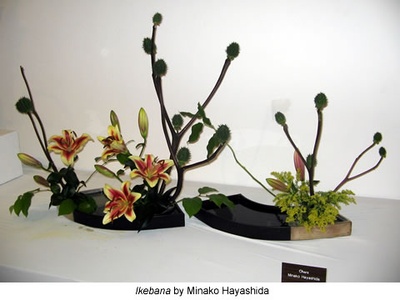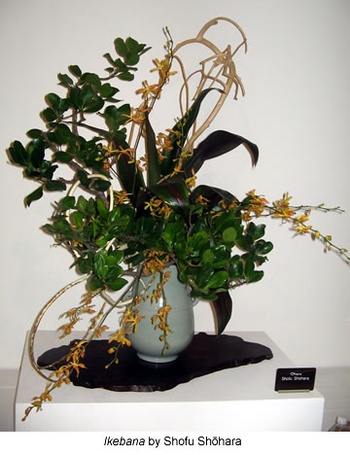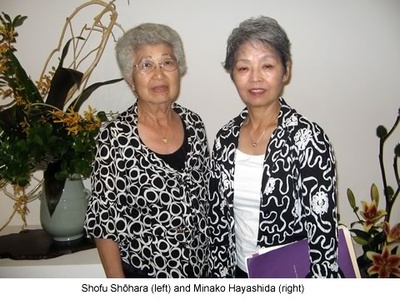Drawn to the Ohara style by its wide spectrum of challenges
As part of the annual Nisei Week celebration, the Kad? Instructors’ Association holds an ikebana exhibition every year. The association transcends the differing styles of Ikenob?, Ohara, and S?getsu, and instructors of each style participate. At the venue inside the Japanese American Cultural and Community Center (JACCC), I asked Minako Hayashida-san of the Ohara school for an interview.
Hayashida-san, who currently heads the Ohara Los Angeles Branch, first came into contact with ikebana in 1983.
“As a person working in jewelry design, I was always looking for ways to sharpen my artistic senses. I didn’t know anything about the Ohara style, but a friend introduced me to Kawamura-sensei, and thanks to meeting such a wonderful teacher, I’ve continued on [with ikebana] for 25 years now.”
Asked about what she was most drawn to about the Ohara style, she referred to “The wide spectrum of challenges. As it originally stems from Ikenob?, there are very traditional aspects of ikebana, but there are also methods wherein one can include things like sculpture work into their pieces. There’s such a wide array of artistic challenges, it makes it all the more worthwhile.”
I thought, perhaps, since she had been a jewelry designer before, that she would chalk up a rough draft of her ideas on paper before working on a piece. But lo and behold, gazing at the material before her, she says she arranges all of her ideas inside of her head.
“I’ve yet to get to the point where I can put together a piece that I’m completely satisfied with. But I do want to continue to enjoy doing ikebana. I originally started ikebana as a means to sharpen my artistic senses, but through it [ikebana], I think the way that I see things has changed. Whenever I look at a piece of art, I now try to think about what the artist was trying to convey through the work. Of course, I hope that my ikebana would also be something that brings inner peace to the viewer, or a work that conveys something—I hope for it to be something that is really moving.”
Hayashida-san is currently running around in preparation for the 40th anniversary event of the Ohara Los Angeles Branch. On October 4th there will be a floral exhibition, and on the 5th there will be a floral performance (demonstration) at the Aratani Theatre in Little Tokyo.
Sharp eyes that capture nature
At the same venue, I met Shofu Sh?hara-san, who entered her 50th year teaching the Ohara style this year. Sh?hara-san, who had been learning ikebana in Japan, moved to the U.S. upon marrying her kibei-Nisei husband in 1957—bringing with her a license as an Iemoto instructor—and began teaching private lessons starting the following year.
“I taught a group of wives of Nikkei Nisei veterans, and about 10 of them would gather at a private residence, and I would instruct there. So my first students of ikebana in the U.S. were Nisei. Since then, I’ve been teaching classes as community service at Los Angeles City College for the past 24 years, and I still do today. The students are American. There are some Nikkei youngsters who come to learn some semesters, but the ones who have remained passionate and committed are all Americans. There are some students who have been coming for 20 years. Ohara places emphasis on the shades and colors of nature. So, people who have a sharp eye for nature tend to continue [learning] for a long time
50 years makes a world of a difference
Sh?hara-san says that it is difficult for Americans to understand that “there is no end to ikebana, no matter how long you’ve continued to work on it.” Indeed, it may seem that upon completing a course on western flower arrangement, one may feel quite accomplished with the skill sets that they have gained. However, with ikebana, it is not uncommon to hear of people who have continued in their studies for decades upon decades. It is proof to how deep ikebana really is.
“Even as an instructor, there are many experiences that are shared with my students in class. I’m learning along with them, as well. In ikebana, there’s nothing that says, ‘OK, this is the end.’ When explaining this to my American students, I mention the Japanese word kad? and translate it as the ‘way of flower,’ and I tell them that this path continues on eternally.”
Aside from LACC, she now teaches for an adult class at Beverly Hills High School. Having taught for 50 years, Sh?hara-san has instructed countless students over the years, but looking back, she says that there is a world of a difference between now and when she first began teaching.
“50 years ago, there was a definite lack of material for the Ohara style, which often incorporates the use of branches. In order to secure some Japanese-esque branches of the season, I planted and grew plum trees and peach trees—as many different types of plants as possible in my yard. If you look at it today, my yard has turned into a jungle (laughs).
Nowadays, thanks to the immersion of ikebana into American society, she says that almost all kinds of material necessary can be found in the local flower markets. Pioneers often experience several hardships in order to set up the foundation for future generations. I guess we can say that ikebana was no exception.
Finally, we asked Shōhara-san, “What does ikebana mean to you?” She replied, “Ikebana is life itself. It’s my life.”
Minako Hayashida profile: Came stateside from Japan in 1971. Entered the Ohara school in 1983. Now retired from the jewelry designing business, she currently puts forth her efforts as the acting head of the Ohara Los Angeles Branch. Resides in Hacienda Heights.
Shofu Shōhara profile: Moved to the U.S. in 1957 with her kibei-Nisei husband. Began teaching the Ohara style in 1958 to wives of Nikkei war veterans. Has been a long-time instructor at the Los Angeles City College and for adult classes at Beverly Hills High School.
© 2008 Keiko Fukuda








